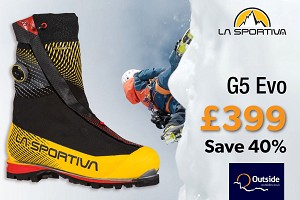

Recently you may have noticed that a new Gore-Tex membrane has begun to enter the market. But what's the difference between this technology and those that the brand have used to date? And why the change? Rob Greenwood explores the complicated world of polymers, the environment, and waterproof fabrics.
Thanks, Rob Greenwood, for an excellent and fully comprehensive report on this issue.
Yesterday, I listened to a one-hour online product overview by Gore and Patagonia in Munich. This was very poor and full of self-congratulations.
Mike Parsons, OutdoorGearCoach ( I am a former WLGore licensee as Karrimor in the 90s!) ) We run cpd courses on PERFORMANCE LAYERING see next course Nov 20th Kendal wall
https://www.outdoorgearcoach.co.uk/blog/performance-layering-course-20-nove...
Really good article, getting your head around fluorocarbon coatings is not easy! Yes PFC-free jackets are not as waterproof for as long, but they are still very good. My Alpkit Definition, one of the first to use PFC-free jacket that were in the market, has gone through 4 seasons of winter climbing without being re-proofed and it's still going strong.
Slightly off topic but how long should Goretex and eVent jackets last? If it's not damaged and I keep reproofing it should be 'forever'? I ask as my kit is around 13 years told (6 years of good steady use, 7 years of much less use) and I was wondering if I should be planning to replace?
David
"On a practical level, ePE has a better strength to weight than ePTFE meaning that the membrane can be both lighter and thinner Most critical of all from a staying dry perspective, the ePE membrane has the same super high hydrostatic head, meaning it's equally suitable for the worst weather."
"ePTFE membrane will continue to feature in Gore Pro products, as a result of it still being the most durably waterproof option available for now."
Hmmmm seems to be a contradiction here! ePE is as good....oh, ePE isn't as good.
In my experience, goretex is fine until it starts to delaminate and you see 'blisters' on the face material. I suspect the type of goretex makes a difference (face material, 2 or 3 layer etc. and my 3 layer breathables have always lasted better than 2 layer ones without a protective inner layer - the membrane material has decomposed relatively quickly in those garments.
Great article. I've found reproofing Gore tex jackets and trousers to involve a very poor pay off between time/money and performance. Sometimes you get a bit more beading on the first use after reproofing but it doesn't seem to last. Pretty worrying if the new ePE fabrics work less well as it will invariably mean more garments in landfill.
Hi All. Rob is away this week. He'll be able to answer specific questions/comments in a few days.
Jeez, wish I had the money to replace a functional waterproof every time it wanted a wash and reproofing.
I binned my last waterproof after about 10 years of service because the face fabric was so worn from backpack straps that you could pull it away like cotton wool. It was still waterproof enough, albeit not as breathable as it once one. Even then it did a few more years service for gardening and as a back up jacket to leave in the car.
I couldn't help but be reminded about the numerous articles looking at the total carbon cost of these greener items across the expected lifetime rather than at purchase point.
Electric cars undoubtedly appear (and are) greener than their combustion engine counterparts .. but .. it's not as clear cut as it appears.
For example: The carbon cost to put an electric car on the road on day 0 of its life is actually higher than the carbon cost to put a combustion engine car on the road on day 0 (at present). However .. it is in the years/miles ahead that the balance tips in favor of the electric car.
https://climate.mit.edu/ask-mit/are-electric-vehicles-definitely-better-cli....
"The researchers found that, on average, gasoline cars emit more than 350 grams of CO2 per mile driven over their lifetimes. The hybrid and plug-in hybrid versions, meanwhile, scored at around 260 grams per mile of carbon dioxide, while the fully battery-electric vehicle created just 200 grams. Stats from the U.S. Department of Energy tell a similar story: Using the nationwide average of different energy sources, DOE found that EVs create 3,932 lbs. of CO2 equivalent per year, compared to 5,772 lbs. for plug-in hybrids, 6,258 lbs. for typical hybrids, and 11,435 lbs. for gasoline vehicles.5"
Fantastic .. electric cars are greener that combustion engine cars AS LONG AS we actually put some miles on them.
So now we have these new "PFC-free DWR treatment" jackets from goretex .. which need more regularly reproofing. That new bottle of Nikwax will be delivered to me in a plastic container, probably via Amazon, driven by an Amazon driver (probably) with a combustion vehicle and I will need to do this multiple times over the expected lifetime of the jacket. Right?
Question: Has goretex provided any lifetime carbon cost numbers vs their older stuff? Is it definitely greener over the full expected life of the jacket.
I have a hunch that unlike electric cars, which have a better carbon footprint compared to combustion engines the more you use them, that the opposite might be true here. i.e. that the more you use these new jackets -> the more regularly they'll need reproofed ... which will slowly increase their carbon footprint relative to the older jackets as you need to acquire more reproof chemicals.
Do I have the wrong end of the stick here?
[1] https://climate.mit.edu/ask-mit/are-electric-vehicles-definitely-better-cli....
"The researchers found that, on average, gasoline cars emit more than 350 grams of CO2 per mile driven over their lifetimes. The hybrid and plug-in hybrid versions, meanwhile, scored at around 260 grams per mile of carbon dioxide, while the fully battery-electric vehicle created just 200 grams. Stats from the U.S. Department of Energy tell a similar story: Using the nationwide average of different energy sources, DOE found that EVs create 3,932 lbs. of CO2 equivalent per year, compared to 5,772 lbs. for plug-in hybrids, 6,258 lbs. for typical hybrids, and 11,435 lbs. for gasoline vehicles.5"
Carbon cost has a different impact than PFCs that were historically used to proof jackets. One is causing atmospheric warming (which will impact biodiversity), the other is causing a reduction in biodiversity and contaminating the food supply, both are bad. If the reproofers were more readily available in supermarkets and the like you wouldn't need to make an additional trip and the carbon cost of the bottles would be significantly reduced.
Rab and the like are now selling reproofers which don't use PFCs, I washed an older event jacket with some and it seems to have done the job of reproofing very well, but I haven't used it much since so can't confirm longevity.
Landfill isn't really used directly anymore. Most councils process waste as energy recovery, aka burning it to make electricity. Obviously still pretty bad, and I'd guess 99% green washed for so called recycling as no doubt most of that goes there too. What's left goes to landfill, not much! Still learning myself. Some US campaginers planted GPS on collected plastics, they all went to energy recovery. Expect it's the same here. Depressing green washing BS.
I've found Goretex items last pretty well - my paclite jacket is going strong at nearly 10, and I have a 30 year old Latok that is still functional at 30+ (though admittedly doesn't get much use the last 15 years). Event in contrast lasts months in my limited experience (but supporte by others)
In reply to StuPoo2: Bear in mind your dodgy EV numbers are entirely reliant on how the power is generated - mine is nearly 100% hydro so the difference is huge. Read the provisos in the article you linked to as you'd be surprised at how the % of renewables in the energy mix in the US (esp. in the S!) is growing. But that's a separate discussion /propaganda argument
The article misses the point a little.
Goretex is an example of a semi permeable membrane - the holes in the membrane are small enough to allow water vapour through but not let liquid water through. That means that, providing the goretex membrane is not damaged, it will always be waterproof. (Goretex was developed for the chemical industry for things like reverse osmosis, and initially applications in the outdoor industry were an unexpected spin-off). To allow water vapour (eg from sweat) to pass through the membrane the humidity on the inside must be greater than the humidity on the outside. If the humidity outside the jacket is approaching 100%, typical of a cold wet day, then its difficult to get vapour through there membrane, and clothing inside the jacket gets damp. Vapour will be body temperature next to the skin but will cool as it passes through clothing to hit your shell layer, where it will condense if there isn't sufficient pressure for it to pass through the membrane. When this happens people complain their jackets are leaking, which isn't usually the case.
I also suspect the article overplays the importance of the DWR coating , maintaining the beading ability by "reproofing" - I've never "reproofed" my goretex jackets, and they still work fine after several years. A short wash with soap will clean the membrane covering, which could help with vapor transmission.
I believe the above is technically correct - plse correct if not! thanks.
i wouldn’t agree on ‘overplaying the importance of the DWR coating’ – it’s integral to what the membrane provides: *breathable* waterproofness.
the membrane being waterproof, no matter what, is not noteworthy. so is a sheet of rubber. what sets it apart is that it is waterproof *while able to vent moisture*. and this ability stops when the face fabric is soaked with water. the membrane might be capable of letting through vapour under certain circumstances, but the water isn’t. therefore, as soon as the face fabric wets out, you are wearing the equivalent of a rubber jacket. a gore-tex (or equivalent) jacket without DWR loses its raison d’etre. (and with that, its raison de spending a three figure sum of money)
however, you are correct that making the circumstances happen so that the garment will get rid of moisture can be gotten wrong, and then it’s easier to (wrongly) say ‘my jacket is leaking’ instead of ‘the microclimate of my clothing system doesn’t match the current weather and activity levels’.
> "On a practical level, ePE has a better strength to weight than ePTFE meaning that the membrane can be both lighter and thinner Most critical of all from a staying dry perspective, the ePE membrane has the same super high hydrostatic head, meaning it's equally suitable for the worst weather."
> "ePTFE membrane will continue to feature in Gore Pro products, as a result of it still being the most durably waterproof option available for now."
> Hmmmm seems to be a contradiction here! ePE is as good....oh, ePE isn't as good.
Sorry for the delayed reply.
You're right, I could have been clearer, although it does highlight how complex and confusing the subject matter is.
Gore Pro is more durably waterproof because - more often than not - it features that C6 DWR treatment. Sitting at the top of the range, it also tends to feature a higher quality nylon or polyester face fabric, which will have a very compact weave, that makes it more resilient both in terms of abrasion resistance and its ability to hold onto the DWR treatment for longer.
Everyone I've spoken to about the ePE membrane has given it extremely high praise. On the flip side, everyone I've spoken to about PFC-Free DWR treatments has been fairly candid about its limitations - which is why I've tried to be quite frank about what to expect (i.e. you're going to have to wash/proof it more often).
> Everyone I've spoken to about the ePE membrane has given it extremely high praise. On the flip side, everyone I've spoken to about PFC-Free DWR treatments has been fairly candid about its limitations - which is why I've tried to be quite frank about what to expect (i.e. you're going to have to wash/proof it more often).
i’ve been mulling over this aspect of increased reproofing ever since you posted the article. (thanks btw – it’s nice to have an accessibly worded overview on the state of a subject so wedged between between gear nerdery and ethics) i can’t help but wonder how this is going to play out. on one hand, it seems to be hard to argue that the greener DWRs are measurably worse and if you want your next waterproof garment to have a slightly better ecological impact, it’s a downgrade you’ll have to swallow.
on the other hand, there is an argument i know from knives that has the potential to reframe this in a more positive way. background: since several decades ago, there have been two camps when it comes to knife steel preference. one camp favours a steel that does all the things better (most notably, never rust, but also stay sharp for as long as possible), while the other favours steels that don’t have much alloying beyond just carbon. these carbon steels will rust if not cared for, will often not hold an edge quite as long, but can be made to be tougher, and are usually a bit easier to resharpen.
there’s a lot of history to how these camps developed and how correct their respective assumptions are for different use cases, but the aspect i’m thinking of is that a carbon steel knife (in many respects a measurably worse material) can foster a sort of closer connection with your tool *because* there is some ritual of repeated care involved.
and i wonder if a need to repeatedly engage with the waterproofness of a garment has the potential to do something similar. it wouldn’t be a negative if more people engaged with how their gear manages to do its thing, instead of just taking it for granted and chuck it when it stops doing so. (let alone think more about what their point of ‘good enough’ is and maybe opt to do without that expedition-ready hardshell at all.)
Yep how many times have we heard goretex say this new membrane is the best. They know we have to ‘believe’ and initially we are dry and happy disciples, then the repellent wears off and we become damp agnostics, finally it delaminates and we become Goretex wet atheists.
Like lapsed congregations we are enticed back and the cycle starts again.
Others have tried to schism the goretex church with similar promises, such as event (absolutely useless) or Neoshell (how well did that work out), or paramo jahovas.
It’s a new claim; I think I’ll not go happy clappy just yet.
isn’t it remarkable in a cost of living crises and reduced discretionary speeding that this offering is cheaper, uses less membrane and lighter softer face fabrics…,, but still is the holy grail.
yours cynically, but pragmatically resigned to getting damp to varying degrees, and intending to manage by hopefully not getting damp and cold simultaneously,
Was eVent that useless? My eVent Latok would still be my main jacket if I was thin enough to fit in it and it's nearing 10 years old. It's been out in some wild weather and kept me dry, although admittedly on really foul days I have got soaked, but so did my friends who were often in Goretex.
My understanding is that the new membrane is less effective and hard wearing than previous generations, but Gore and the like are having to reduce the environmental impact of the product.
Event; I had one item, four or five friends had items they all failed in a very short time frame.
> In reply to StuPoo2: Bear in mind your dodgy EV numbers are entirely reliant on how the power is generated - mine is nearly 100% hydro so the difference is huge. Read the provisos in the article you linked to as you'd be surprised at how the % of renewables in the energy mix in the US (esp. in the S!) is growing. But that's a separate discussion /propaganda argument
I'm just impressed you actually read my article ...
Please help UKClimbing continue to provide varied and free content by becoming a UKC Supporter, or UKC Supporter Plus which includes discounted products from Rockfax.
Become a Supporter









